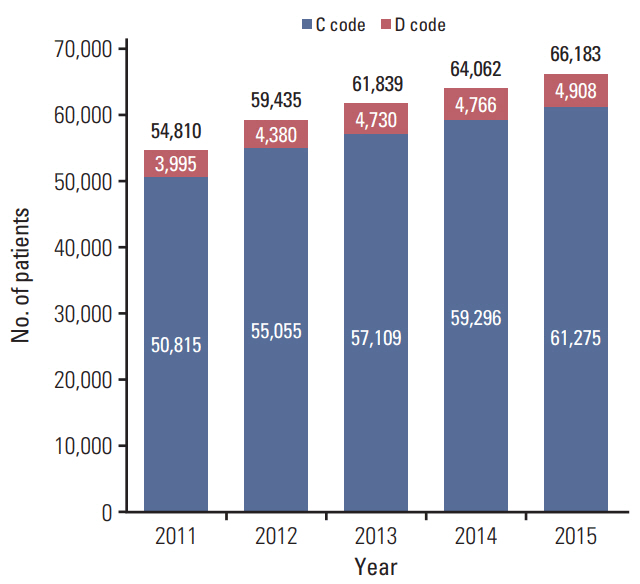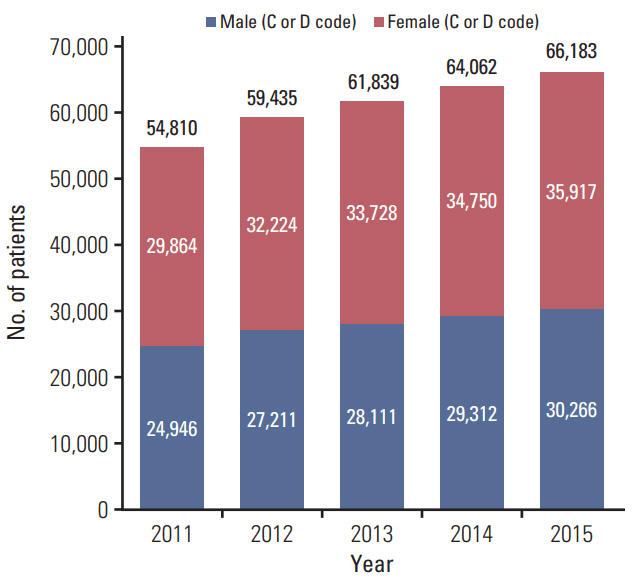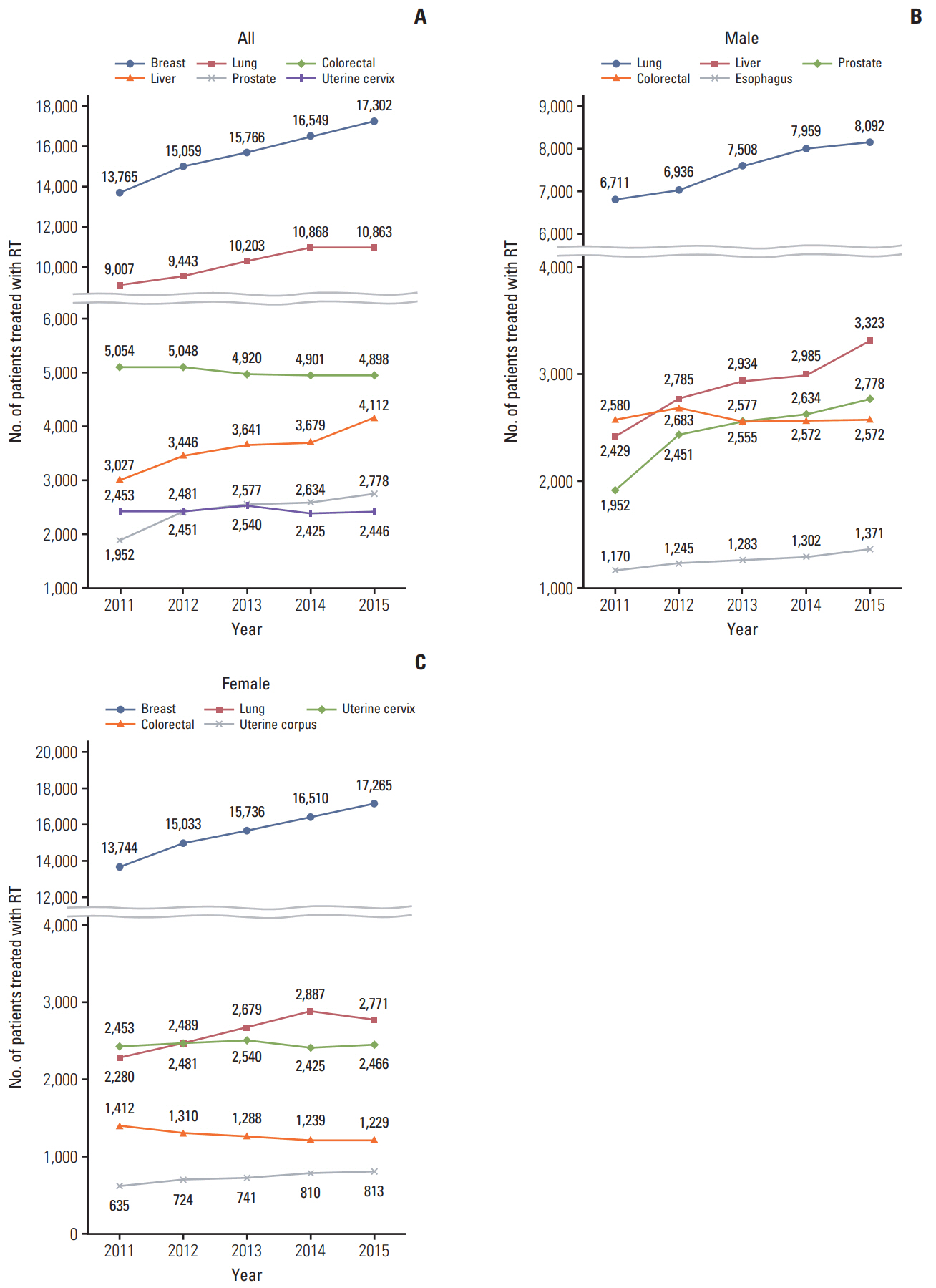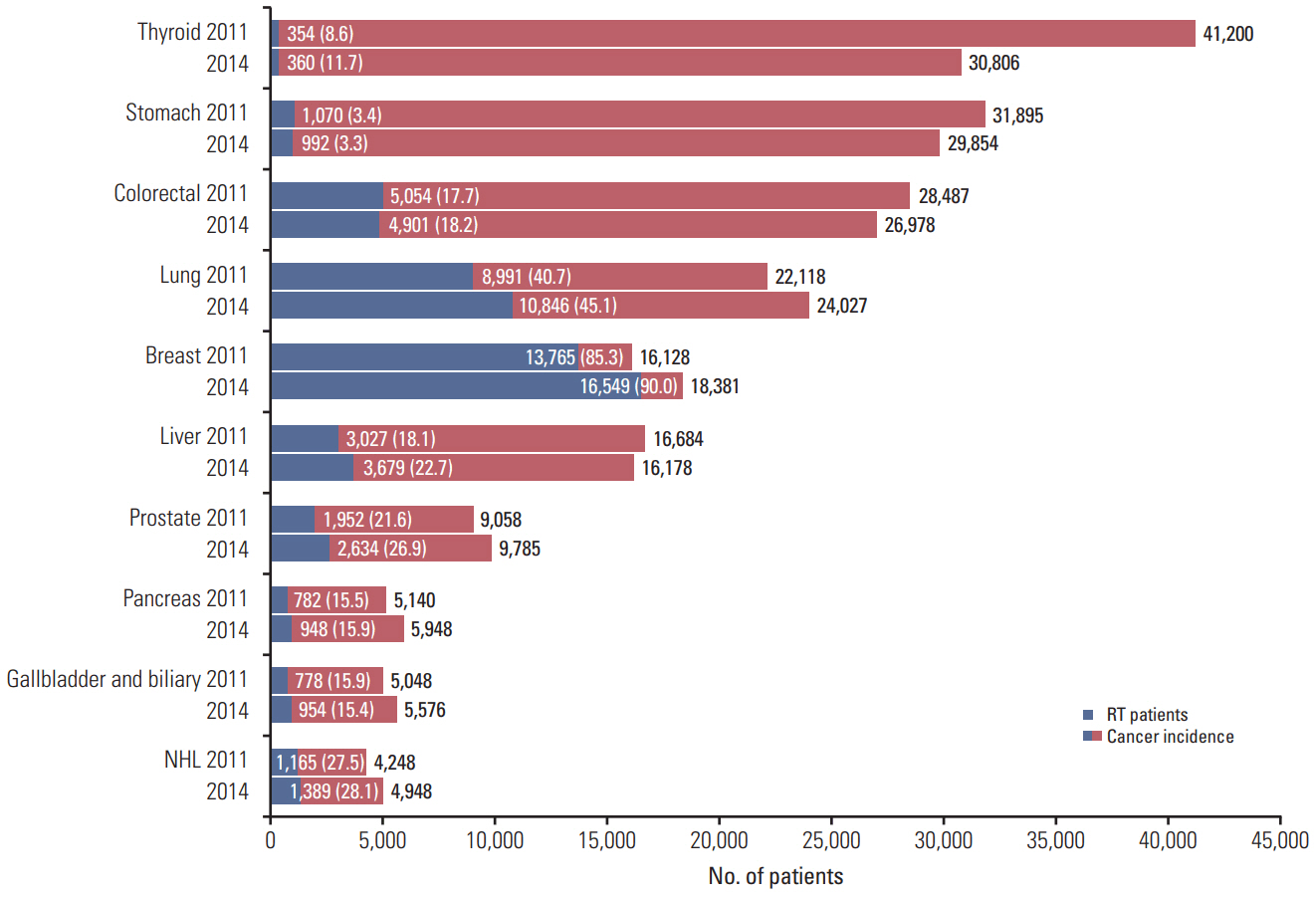Cancer Res Treat.
2018 Apr;50(2):345-355. 10.4143/crt.2017.096.
The Clinical Utilization of Radiation Therapy in Korea between 2011 and 2015
- Affiliations
-
- 1Department of Radiation Oncology, Korea Institute of Radiological & Medical Sciences, Seoul, Korea. mskim@kirams.re.kr
- 2Radiation Medicine Policy Development Center, Korea Institute of Radiological & Medical Sciences, Seoul, Korea.
- 3National Radiation Emergency Medical Center, Korea Institute of Radiological & Medical Sciences, Seoul, Korea.
- 4Department of Biostatistics, Korea University, Seoul, Korea.
- KMID: 2411124
- DOI: http://doi.org/10.4143/crt.2017.096
Abstract
- PURPOSE
The purpose of this study was to estimate the clinical utilization of radiation therapy (RT) in Korea between 2011 and 2015.
MATERIALS AND METHODS
We analyzed the claims data from the Health Insurance Review and Assessment Service to estimate the clinical utilization of RT. The source population consisted of all patients who had any of the International Classification of Diseases 10th revision cancer diagnoses (C00-C97) and those with diagnostic codes D00-D48, who were also associated with at least one of the procedure codes related to RT.
RESULTS
The total number of patients who received RT in 2011, 2012, 2013, 2014, and 2015 were 54,810, 59,435, 61,839, 64,062, and 66,183, respectively. Among them, the total numbers of male and female patients were 24,946/29,864 in 2011, 27,211/32,224 in 2012, 28,111/33,728 in 2013, 29,312/34,750 in 2014, and 30,266/35,917 in 2015. The utilization rate of RT in cancer patients has also increased steadily over the same period from 25% to 30%. The five cancers that were most frequently treated with RT between 2011 and 2012 were breast, lung, colorectal, liver, and uterine cervical cancers. However, the fifth most common cancer treated with RT that replaced uterine cervical cancer in 2013 was prostate cancer. More than half of cancer patients (64%) were treated with RT in the capital area (Seoul, Gyeonggi, and Incheon).
CONCLUSION
The total number of patients who underwent RT increased steadily from 2011 to 2015 in Korea. The utilization rate of RT in cancer patients is also increasing.
Keyword
MeSH Terms
Figure
Cited by 1 articles
-
Who Will Benefit from Charged-Particle Therapy?
Kyung Su Kim, Hong-Gyun Wu
Cancer Res Treat. 2021;53(3):621-634. doi: 10.4143/crt.2021.299.
Reference
-
References
1. National Cancer Center. Cancer statistics in Korea: incidence, mortality, survival, and prevalence [Internet]. Goyang: National Cancer Center;2017. [cited 2017 Jan 17]. Available from: http://ncc.re.kr/cancerStatsView.ncc?bbsnum=397&searchKey=total&searchValue=&pageNum=1.2. Slotman BJ, Cottier B, Bentzen SM, Heeren G, Lievens Y, van den Bogaert W. Overview of national guidelines for infrastructure and staffing of radiotherapy. ESTRO-QUARTS: work package 1. Radiother Oncol. 2005; 75:349–54.
Article3. Kang JK, Kim MS, Jang WI, Seo YS, Kim HJ, Cho CK, et al. The clinical utilization of radiation therapy in Korea between 2009 and 2013. Radiat Oncol J. 2016; 34:88–95.
Article4. Kang JK, Kim MS, Jang WI, Kim HJ, Cho CK, Yoo HJ, et al. The clinical status of radiation therapy in Korea in 2009 and 2013. Cancer Res Treat. 2016; 48:892–8.
Article5. National Index System, Population in 2015 [Internet]. Daejeon: Statistics Korea;2017. [cited 2017 Jan 17]. Available from: http://www.index.go.kr/potal/main/EachDtlPageDetail.do?idx_cd=1007.6. Lee N, Tuttle M. The role of external beam radiotherapy in the treatment of papillary thyroid cancer. Endocr Relat Cancer. 2006; 13:971–7.
Article7. Park SH, Kim JC, Kang MK. Technical advances in external radiotherapy for hepatocellular carcinoma. World J Gastroenterol. 2016; 22:7311–21.
Article8. Kang JK, Kim MS, Cho CK, Yang KM, Yoo HJ, Kim JH, et al. Stereotactic body radiation therapy for inoperable hepatocellular carcinoma as a local salvage treatment after incomplete transarterial chemoembolization. Cancer. 2012; 118:5424–31.
Article9. Paik EK, Kim MS, Jang WI, Seo YS, Cho CK, Yoo HJ, et al. Benefits of stereotactic ablative radiotherapy combined with incomplete transcatheter arterial chemoembolization in hepatocellular carcinoma. Radiat Oncol. 2016; 11:22.
Article10. Rim CH, Seong J. Application of radiotherapy for hepatocellular carcinoma in current clinical practice guidelines. Radiat Oncol J. 2016; 34:160–7.
Article11. Bae BK, Kim JC. The response of thrombosis in the portal vein or hepatic vein in hepatocellular carcinoma to radiation therapy. Radiat Oncol J. 2016; 34:168–76.
Article12. Seol SW, Yu JI, Park HC, Lim DH, Oh D, Noh JM, et al. Treatment outcome of hepatic re-irradiation in patients with hepatocellular carcinoma. Radiat Oncol J. 2015; 33:276–83.
Article13. Korean Liver Cancer Study Group (KLCSG); National Cancer Center Korea (NCC). 2014 KLCSG-NCC Korea practice guideline for the management of hepatocellular carcinoma. Gut Liver. 2015; 9:267–317.14. Barton MB, Jacob S, Shafiq J, Wong K, Thompson SR, Hanna TP, et al. Estimating the demand for radiotherapy from the evidence: a review of changes from 2003 to 2012. Radiother Oncol. 2014; 112:140–4.
Article15. Borras JM, Lievens Y, Dunscombe P, Coffey M, Malicki J, Corral J, et al. The optimal utilization proportion of external beam radiotherapy in European countries: An ESTRO-HERO analysis. Radiother Oncol. 2015; 116:38–44.
Article16. Rosenblatt E, Barton M, Mackillop W, Fidarova E, Cordero L, Yarney J, et al. Optimal radiotherapy utilisation rate in developing countries: An IAEA study. Radiother Oncol. 2015; 116:35–7.
Article17. Mackillop WJ, Kong W, Brundage M, Hanna TP, Zhang-Salomons J, McLaughlin PY, et al. A comparison of evidence-based estimates and empirical benchmarks of the appropriate rate of use of radiation therapy in ontario. Int J Radiat Oncol Biol Phys. 2015; 91:1099–107.
Article18. Chung K, Han Y, Kim J, Ahn SH, Ju SG, Jung SH, et al. The first private-hospital based proton therapy center in Korea: status of the Proton Therapy Center at Samsung Medical Center. Radiat Oncol J. 2015; 33:337–43.
Article19. Huh SJ; Korean Society of Therapeutic Radiology and Oncology (KOSTRO). Current status of the infrastructure and characteristics of radiation oncology in Korea. Jpn J Clin Oncol. 2007; 37:623–7.
Article
- Full Text Links
- Actions
-
Cited
- CITED
-
- Close
- Share
- Similar articles
-
- Trends in radiation therapy facilities-1986 to 1991
- A Survey of Radiation Therapy Utilization in Korea from 2010 to 2016: Focusing on Use of Intensity-Modulated Radiation Therapy
- Number of Radiation Oncologists in Korea, Adequate or Surplus?
- Proton Therapy Review: Proton Therapy from a Medical
- Trends in utilization of neoadjuvant and adjuvant chemotherapy for muscle invasive bladder cancer






